The winter break is finally over and football has returned back to Spain, and more importantly, to Catalunya. Barcelona had a really tough fixture with a trip to the capital to face Getafe at the Coliseum Alfonso Perez. After a thrilling performance from both sides, it was the guests who took the full spoils of a truly even match.
As a result, the Blaugrana have been crowned winter champions of La Liga, topping it at the halfway mark for the second year in a row. Getafe’s failure to stop the Catalans also meant that the latter’s lead extends to five points over Atletico Madrid, seven over Sevilla, nine over Deportivo Alaves and even more impressively, 10 over Real Madrid. Yet the bookmakers are still not convinced that this Barcelona team is good enough to win the big one; the Champions League. Cast your eyes over the odds at a well-reviewed site like betDSI, find the best prices available on Barca taking the crown away from their big rivals.
This tactical analysis will use statistics to determine how Barcelona managed to break the second best defence in Spain to claim what feels like the most important three points of the first part of the season.
Line-ups
Barcelona (4-3-3)
Starting XI: Ter Stegen – Sergi Roberto, Pique, Lenglet, Alba – Vidal, Rakitić, Arthur – Messi, Suarez, Dembele
Bench: Cillessen, Murillo, Semedo, Aleña, Coutinho, Busquets, Malcom
Coach: Ernesto Valverde
Getafe (4-4-2)
Starting XI: Soria – Djene, Antunes, Cabrera, Mata, Portillo, Angel, Arambarri, Maksimovic, Damian, Doulquier
Bench: Chichizola, Bruno, Samu Saiz, Cristoforo, Flamini, Ibanez, Molina
Coach: Pepe Bordalas

Barcelona’s set-up
There were not many doubts about Ernesto Valverde’s preferred XI before the game, so the actual players that were fielded on Sunday didn’t surprise anyone. What could be described as his best available side graced the pitch in Madrid with only a couple of exceptions.
Sergi Roberto returned from injury which saw him immediately replace Nelson Semedo, raising a couple of eyebrows in the process. Ousmane Dembele was selected in front of Philippe Coutinho, chaining the Brazilian to the bench even longer. The Ant decided to rest Sergio Busquets who’s still on a slight recovery path. Instead, he selected Ivan Rakitić in his position to deputize for the Spaniard’s absence. New signing Jeison Murillo was on the bench but did not get to play.
On paper, Barcelona operated in the 4-3-3 system that they are so familiar and comfortable with. On the pitch, however, it was a mix of almost every trick Valverde had in the bag. The squad swapped between formations based on the situation, which ultimately resulted in a variety of different systems used. We’ll look at that a bit later.
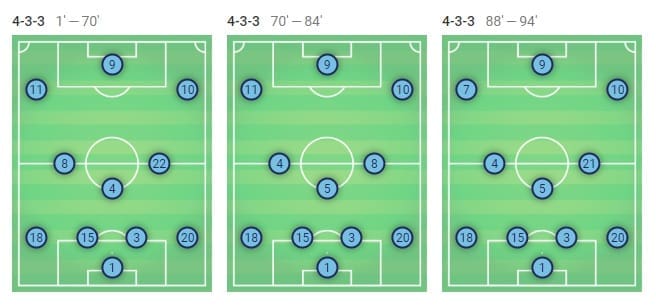
Getafe’s set-up
The hosts played it safe, as they have done this season, with few changes to their first-choice XI. The defensive line remained completely the same so the back four that shielded David Soria was unchanged. The most interesting change happened up front.
Getafe’s prolific striker, Jorge Molina, was left on the bench. Instead, Jaime Mata joined Angel Rodriguez up front in the 4-4-2 system the hosts have used 24% of the time.
Some tactical changes were seen depending on whether the team was instructed to stay behind the ball, soak up the pressure or be the pressing team. In most cases, they did remain faithful to the 4-4-2 formation.
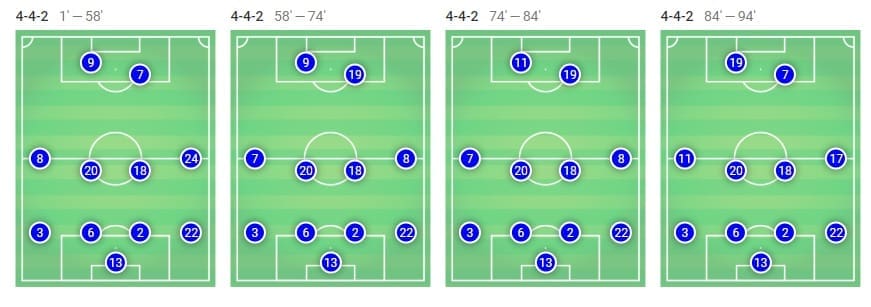
A “broken” game
If you are a neutral fan, there is nothing much more entertaining than a completely even game. In Spain, they refer to those as “broken” games. Far from being broken, Sunday’s thriller was right up that alley: fun, competitive, and even.
Getafe are currently on an incredible high point in their campaign, even after the home defeat to the winter champions. At the moment, alongside Atletico Madrid, they have the best defence in La Liga with only 15 goals conceded.
Bordalas decided to play it safe which saw the hosts yield 76% possession to the away team and wait for the right moment to strike. A very solid and compact 4-4-2 meant that the middle of the park was largely congested and ball progression through there was nearly impossible. This forced Barcelona out wide to the wings.
Still, this brings us to the first big tactical approach of the Catalans. Even though Messi and Dembele were out-and-out wingers on paper, on the pitch both of them played a more interior role. In general, they almost always occupied the half-spaces behind the striker, but that played right to their strengths.
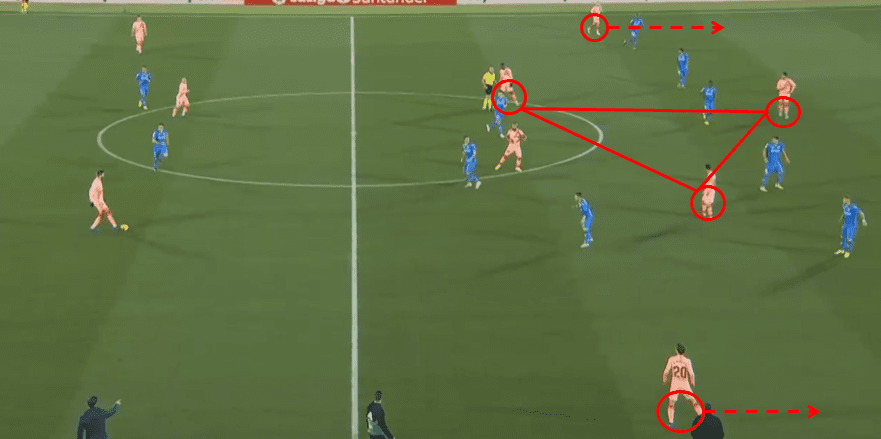
The Argentine’s positioning is not surprising as Leo does this every game, but Dembele is the interesting one to note here. Instead of his usual wide positioning, the young Frenchman was placed at left midfield, similarly to Jordi Alba who’s been Barcelona’s biggest attacking outlet in recent times.
In order to let Alba do what he does best – overlap with his high pace – Dembele had to adopt a different approach. By dropping just slightly deeper to this left half-space, he not only got to cut inside, which he is also prone to doing, but he also intentionally freed Alba of one of his markers.
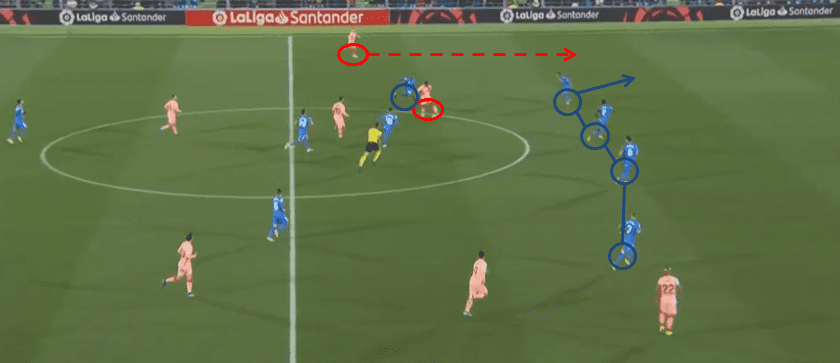
Notice how the five-man back line is broken and is now a standard four-man defence. This is the result of Dembele constantly dragging Foulquier deeper to the centre of the pitch. What would usually be a marking tandem of Foulquier and Suarez turned into a one-man task for the latter defender. In a direct 1v1, Alba’s pace was often too much for the right-back to handle.
Seeing how that worked very well, Barcelona stuck to their guns and maintained the pressure on the left. In the end, they attacked through that side a dominating 44% of the time, as opposed to using the right (27%) and the middle (29%) far less.
Sometimes it was Damian being dragged with Dembele and sometimes it was Foulquier, but the results were mostly identical whichever was the case.
Getafe had a different approach. Yielding possession to Barcelona is not surprising but considering the amount they did get, the hosts used it almost perfectly. Looking solely at the heatmaps, we can immediately see that most of their touches were actually made in their own half.
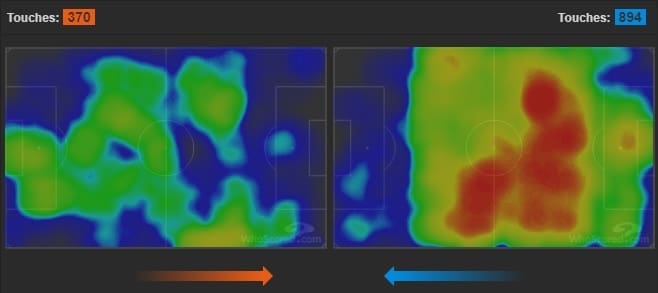
Although this was due to the high press and possession domination of Barcelona, it was also by design, at least to some extent. The idea was to get as many crosses as possible into the box and to do it quickly while both the opposition’s full-backs were still deep in enemy territory.
All of Getafe’s clear-cut chances were created on the break and with a long cross into the box, as can be seen below when the goal actually happened. They quickly change the side and find a free man on the flanks. A good cross that happens before Alba can cover his man means that Lenglet has two attackers to mark.

Even though they scored just that one goal, the hosts were extremely close to more, hitting the post once, and rattling the net before that but getting the goal disallowed shortly after. Interestingly enough, those chances followed an extremely similar pattern to the one showcased above.
In attack, they would always build towards the wings but would then suddenly stop somewhere around the middle of the park. Progression was made extremely difficult with the setup they preferred. Numerical superiority was achieved in defence but not in attack.
Barcelona, on the other hand, swapped through a variety of systems. The default one was still the 4-3-3 but it was actually rarely that simple and straightforward.
Koeman incarnated
The most interesting thing was definitely Rakitić dropping in between the centre-backs in the lavolpiana position. This transformed the guests into a 3-4-3 formation that sometimes resembled a 3-5-2 when Dembele dropped deeper to make it a five-man midfield.
Rakitić would stay deeper when the opposition pressed but if progress was made, the Croat would naturally slide into the regular pivot position just behind Arthur Melo and Arturo Vidal.
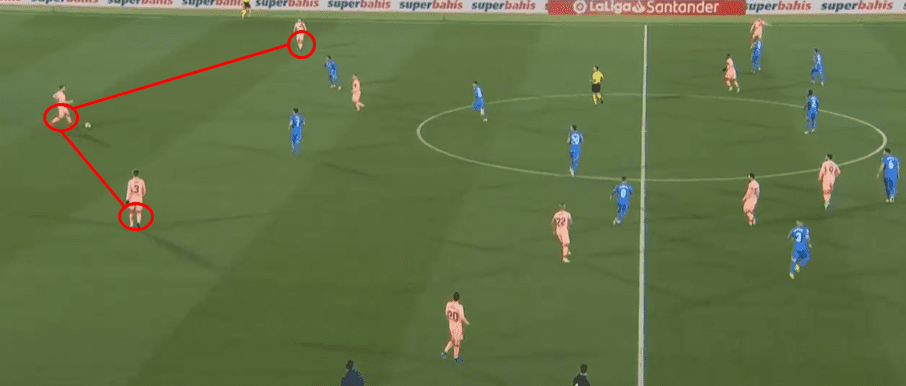
This was a win-win situation for Barcelona’s midfield as Rakitić was free enough from any real press and had the whole pitch in front of himself to orchestrate. Arthur meanwhile would be the one carrying the ball forward with his twists and turns.
As a result, both had an exceptionally great game and were crucial going both ways. Even though Getafe created lots of chances, Barcelona were firmly in control of the game. But still, considering the overall takeaways, the hosts did not do much wrong defensively.
Both goals that the Catalans scored were created out of nothing. One was Messi magic and the other a superb Suarez volley which was simply unstoppable. But defence wasn’t going to win them the game, or draw it, for that matter.
Bordalas had to take a leap of faith. And he did.
The Hail Mary
Getafe’s ace up the sleeve was none other than Jorge Molina, and the coach didn’t wait too long to introduce his striker onto the pitch. Molina replaced the more defensive oriented Dimitri Foulquier and the home team were in a do or die position.
This did bring some chaos into the game, and it seemed that Ernesto Valverde would have to react to re-establish control of the game. So he made his substitutions as Busquets, and eventually Coutinho and Alena, were introduced.
This new and more attacking Getafe had Molina and Angel up front while Mata and Portillo occupied the left and the right wings respectively. The plan was still the same, though: wait for the chance to break, and make quick transitions.
Unfortunately, the open goal miss from Mata meant that the Azulones would not share the points at the Coliseum. Barcelona got more possession back as the game dragged on, and eventually calmed down, and that resulted in the lack of any true chances for the hosts by the final whistle.
Conclusion
It’s difficult to not mention that a bit of luck was on Barcelona’s side as they secured the important three points to break away from the rest of the pack. Open goal misses, hitting the post, and having a goal disallowed is not really something that happens that often. Especially not all of it in one game.
Still, individual brilliance prevailed, as it so often does for the Catalans nowadays, and Getafe just couldn’t match that with any of their own. They did, however, give the hosts a run for their money, which was highly expected even prior to the game.
A hectic schedule for the winter champions means that we could see some interesting rotations and tactical changes implemented by Ernesto Valverde in the near future. The first part of the season is behind us but the fun is just starting.
Buckle up.
If you love tactical analysis, then you’ll love the digital magazines from totalfootballanalysis.com – a guaranteed 100+ pages of pure tactical analysis covering topics from the Premier League, Serie A, La Liga, Bundesliga and many, many more. Get your copy of the FIRST of two December issues for just ₤4.99 here, or the SECOND of the December issues with an annual membership right here.

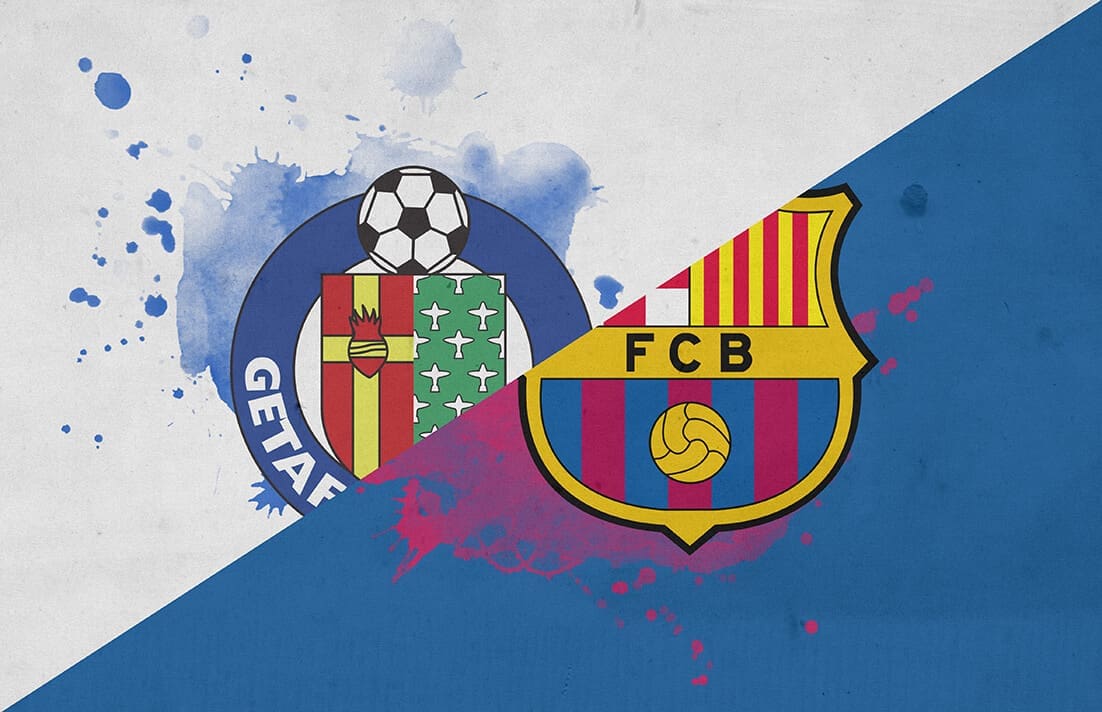




Comments